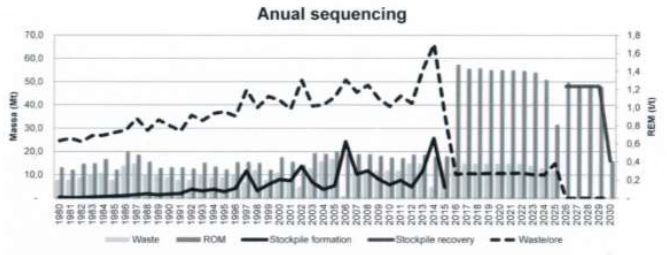Serviços Personalizados
Journal
Artigo
Indicadores
-
 Citado por SciELO
Citado por SciELO -
 Acessos
Acessos
Links relacionados
-
 Similares em
SciELO
Similares em
SciELO
Compartilhar
Revista de Medio Ambiente y Mineria
versão impressa ISSN 2519-5352
REV. MAMYM vol.7 no.1 Oruro jun. 2022
ARTÍCULOS ORIGINALES
Mine wate sequencing on iron ore project
Adilson Curi, Carlos Arroyo, Jorhs Enrique Casimiro Huayhua
Federal University of Ouro Preto, School of Mines, Department of Mining Engineering.
curi@ufop.edu.br, carroyo@ufop.edu.br, jorshcasimiro@gmail.com
Artículo recibido en: 10.03.2022 Artículo aceptado: 04.04.2022
Resumen
Los recursos minerales disponibles en nuestro planeta son finitos, aunque su potencial no sea conocido en su totalidad. El diseño de un proyecto minero, desde las actividades de exploración para conocer el depósito mineral, explotarlo y el cierre de una mina, puede influir la vida útil de la mina. El objetivo de este estudio es evaluar la forma de disposición selectiva de los residuos de una mina de hierro y su posible reutilización en el futuro, destacando su uso y posibles repercusiones en la extensión de su vida útil de una mina de hierro localizada en el Quadrilatero Ferrifero. Recursos y reservas han sido evaluados, así como las fases finales e intermediarias, la secuencia de minado y disposición de residuos. La metodología ha sido empleada en un depósito de hierro brasilero en operación. En donde se pretende demostrar la importancia de evaluar los materiales residuales a fin de prolongar la vida útil del yacimiento mineral.
Palabras Clave: planificación minera, metodología, residuos, yacimiento de hierro
Abstract
The available mineral resources on our planet are finite, although its potential is not fully known. The design of a mining project, from exploration activity for knowledge of a deposit, through mining and closure of a mine, can influence the life extension of the mine in a mining operation.
This study aims to evaluate the waste material of iron formation in mining for selective disposal and future reuse, highlighting its use and potential impacts on life extension in an iron ore mine in the Iron Quadrangle. Resources and reserves were evaluated, the final and intermediate pits, mine sequencing and waste disposal. The methodology was applied to a case study of an operating mine. It is intended to demonstrate the importance of evaluating the waste materials in order to extend de life of mine.
Keywords: mine, planning, design, methodology, waste, iron ore
1. INTRODUCTION
A mine project is the set of studies necessary for the implementation of a mine, where such studies require a wide variety of technical expertise and cover different types of engineering, which are complementary [1] .The mining industry, like any other enterprise, has as its basic economic objective to maximize its future wealth. However, it is characterized by the economic exploitation of an exhaustible and non-renewable capital asset, which is different from other industries [2].
Iron ore deposits are most often mined as open pit operations, where relatively high ore grade and high-tonnage production generates significant amounts of solid waste, subdivided generally into two major categories: mill tailings and waste rock [3]. According to [4] a waste dump design is usually not as critical or as detailed as mine design. However, good waste dump design can be critical in minimizing costs and increasing the value of the ore produced. As discussed by [5] to achieve the desired degree of stability, selective placement of competent, free-draining waste rock in critical areas is required to promote drainage and provide integrated buttressing. The reserve block model can be adapted for this purpose.
Each block of waste must be classified based on its predominant alteration type, mineral content or other parameters of interest. Both the mine plan and the waste dump development sequence must be adjusted to ensure that there was sufficient high-quality waste available during a given year to meet the minimum requirements for construction of critical dump components [5]. It is necessary to manage waste in the pit similar to those used to selectively mine the ore, even with grade control support.
In the absence of an international consensus, [6] proposes a set of principles to guide the disposal of mining and mineral processing wastes, in order not to significantly disturb the ecosystems, communities and economies overlying and surrounding ore deposits and processing facilities. It and can be applicable to manage different types of solid wastes. One of the fundamental principles attests that mining, mineral processing and waste management technologies which offer improved environmental and social performance and a smaller surface footprint should be preferentially adopted. Opportunities for re-use of waste material should be pursued when practicable [7]. This case study represents only one possible scenario for re-using waste rock from an open pit iron ore mine.
2. METHODS
The selected property is an operation located at Itabira iron ore complex, north-east extreme of the Iron Quadrangle, at Minas Gerais state, as shown in Fig. (1). The geology information and the topography map have been graciously provided by Vale mining company. The mineral deposit rocks belongs to the Cauê formation, group Itabira, supergroup Minas. Mineralization is represented by two major lithological types: itabirites and hematites. There are other ferruginous materials, such as anphiboles, besides non-ferruginous rocks such as phyllites, schists and quartzites, quartz, goethite and breccia. A superficial ferruginous crust denominated locally as canga (cangue) is very frequent in the superficial areas [8].
In terms of the conventional mine proposal, the materials classified as mine waste are generally the materials without enough economic value to pay its process or without an available mine process flow sheet. For example, in a traditional exploitation of hematite, the itabirites may be considered as mine wastes. However, considering the exhaustion of the hematite reserves, it is important to study the possibilities for disposing the itabirite selectively as a marginal ore for a future recovery. In the same way, the same principles may be applied to others ferruginous materials such as poor and compact itabirites and other ferruginous wastes [9]. This methodology gets to an increase in the life of mine, improving the mine cash flow and generating several direct and indirect benefits for the surrounding communities, such as employment, taxes and services. The negative impacts of the exploitation are an increase in the average haulage distance, fleet and costs to legal and environmental regulation of the waste dumps [10].
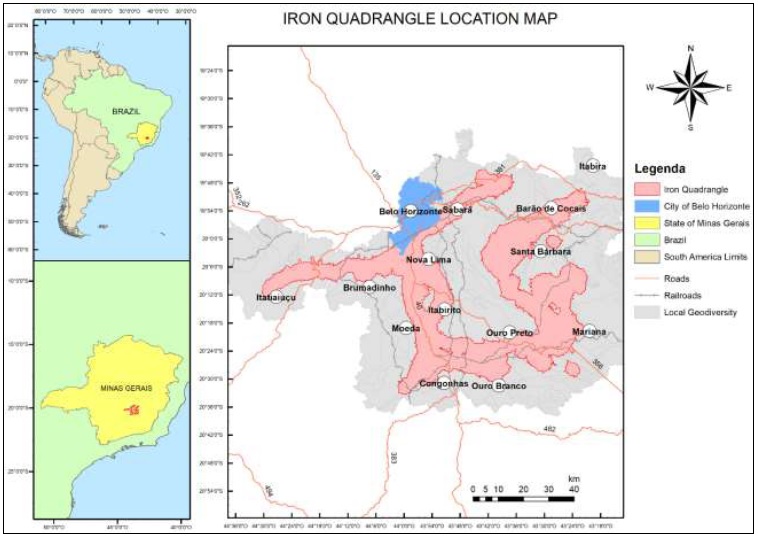
Fig. 1: Itabira iron ore complex is located on the north-east extreme of Iron Ore Quadrangle
Nowadays, at Itabira complex the mines "Conceição" and "Minas do Meio" are in exploitation of the iron ores (hematites and itabirites). Total production is approximately 50 million tonnes (Mt) of sinter feed and pellet feed.
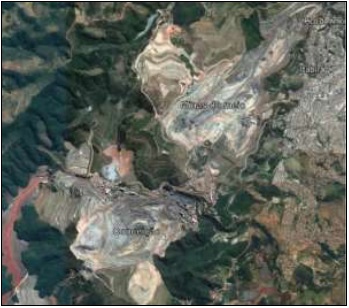
Fig. 2: Mines "Conceição" and "Minas do Meio” at Itabira complex
The geological model has lithologies and respective densities listed in the Table 1.

Table 1: Rock types and density
To evaluate iron ore reserves and perform ore and waste mine scheduling the following methodology was used:
1) Classification of the material according to available processing plant;
2) Reserves evaluation;
3) Sequencing of the mine blocks according to production targets.
2.1.- CLASSIFICATION OF THE MATERIAL ACCORDING TO AVAILABLE PROCESSING PLANT
Currently the mine has two mineral processing plants, according to Reserves and Resources evaluation report from [11], one for hematite and another one for rich itabirites, generating as products sinter feed and pellet feed. In 2014 started the operation of a new mineral processing plant for poor and compact itabirites.
The itabirites plant requires minimum 48% of iron ore. The cut off grades were obtained by the technique of parametrization considering measured, indicated and inferred blocks and the basic topography of 1980. Lithologies were grouped according to list below:
• Hematites (he): including lithologies hc, hf, hp, hmn;
• Itabirites (it): including lithologies ic, if, is, ih, imn, cg.
For the hematite the cut-off is geological, considering that its iron content is even greater than 60%. Table 2 shows the parameterization for the itabirites, where a cut-off off 42.5 % results in a ROM (Run of Mine) of 48.8% Fe, according to grades required by the current processing plant. Furthermore, in the incremental column it is possible to observe that the mass below 42,5% corresponds to 650 Mt of itabirites, with an average grade of 39% of iron. Potentially this mass below the cut-off could be processed anytime in the future with the development of the mineral processing technologies.
Finally, rockypes are defined considering the cut of grade, lithotypes and available mineral processing plant as is presented next:
• Hematites (he): hc, hf, hp and hmn; measured, indicated and inferred resources, iron grade above 42,5 %;
• Itabirites (it): if, ih, cg; measured, indicated and inferred resources, iron grade above 42,5 %;
• Poor and compact Itabirites (ic): ic, is, imn; measured, indicated and inferred resources, iron grade between 27.5 % and 42,5 %;
• Ferriferous waste (ff): ido and hdo; measured, indicated and inferred resources;
• Others Ferriferous waste (ffne): others ferriferous lithotypes not estimated;
• Waste (estfr): all the others blocks with non-ferriferous lithotypes.
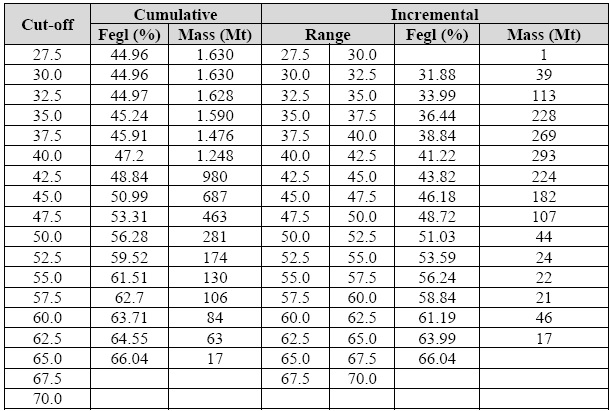
Table 2: Parameterization of the itabirites
2.2.- MINERAL RESERVES EVALUATION
According to [12], the economic value for each block is calculated from the block grades and estimated mining costs, using a method called benefit function (BF) to define the economic net value of each block, by calculating the difference between the revenue based on contained metal and the costs of metal production. From the economic block values, the final pit may be calculated using one of the several available optimization techniques. In this case the L&G algorithm from Vulcan software was used. A bi-dimensional vision for open pit block model restricted by topography and ultimate pit limits is presented in Fig. (3).
Plan 2014 separates the operation into two periods. Before 2014, main ores are hematites (in red) and rich itabirites (light blue). After 2014, its also possible to use compact itabirites (dark blue). The compact itabirite mined before 2014 should be disposed separated from non-ferruginous waste, as shown in next sections.
Thus, mine reserves are presented in 2 cases:
• Case 1: between topography from 1980 and 2014 mine plan;
• Case 2: between 2014 mine plan and final pit.
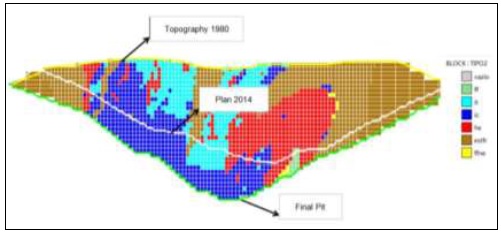
Fig. 3: Evaluation of the reserves between 1980, the mine plan of 2014 and the ultimate open
pit for the mine. Source: designed using Vulcan software
Results for two situations are shown in Table 3.

Table 3: Reserves by rocktype and situation
2.3.- SEQUENCING OF THE MINE BLOCKS
The block model sequencing was established considering the basic premises described below.
Production objectives in case 1:
• exploitation of hematite;
• production of 10 Mtons per year of rich itabirite (“it” with iron grade above of 42,5 %);
• stock compact and poor itabirites (“ic” with iron grade between 27.5 and 42,5 %).
As 2014 is the start up for processing poor itabirites, production objectives in case 2 are:
• production of 48 Mtons per year of itabirites (rocktypes “it” and “ic”);
• production of 8 Mtons per year of hematites.
There is an additional case, which is stock recovery, as follow:
• Production of 48 Mtons per year of itabirites from the stockpile (rocktypes “it” and “ic”).
Figure 4 presents the current configuration of the Conceição mine. The green and yellow polygons are the mineral processing plants, being the current mineral processing plant on the right and the new mineral processing plant on the left.
Table 4 presents the results of the results of the proposed annual mine sequencing during the period of 1980 through the final life of the mine on 2030. The mass of poor and compact itabirites mined between 1980 and 2014 was of 208 Mt. The exhaustion of the mine will be in 2025. After 2025, the marginal waste stock pile can be mined using the same mineral processing plant. The stock has enough quantity for a 5 years period.
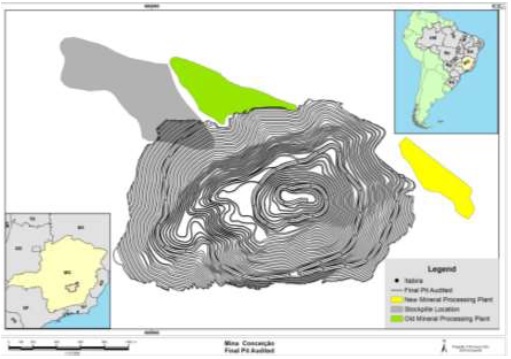
Fig. 4: Waste pile location (grey) and the new mineral processing plant (green polygon)
3. RESULTS AND DISCUSSIONS
Figure 5 presents the mine sequencing (mine scheduling) for the entire life of mine, the annual production in terms of the "Run of mine" (ROM), waste, marginal waste stockpiled, and marginal waste processed after the exhaustion of the mine, between 2025 and 2030.
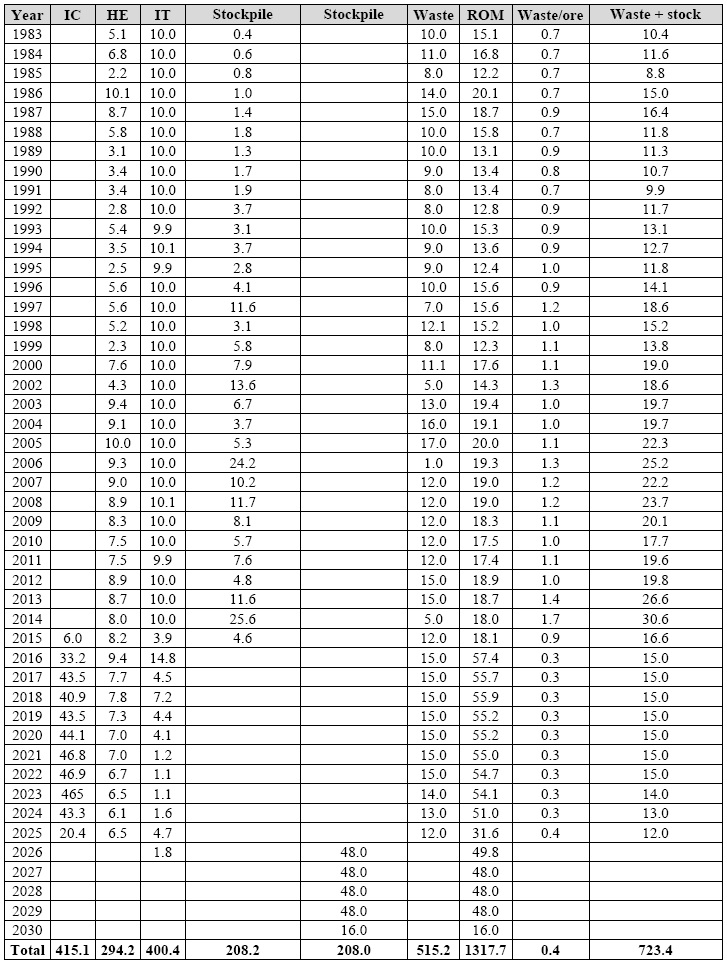
Table 4: Reserves by rocktype and situation
The mine scheduling gets to a stock of 208 Mt of poor and compact itabirite. It will be necessary to choose an appropriate area to stockpile this material facilitating its recovery in the future. The material must be placed on a separate marginal waste stockpile from the non-ferriferous material. Considering the location of the projected mineral processing plants the best location for the marginal waste pile will be in the yellow area, nearest to both mineral processing plants, as shown in Fig. (4). In this place was constructed a marginal waste pile to stock 100 Mt of the poor and compact itabirites and this stockpile can be expanded to stock 200 Mt.
CONCLUSION
The mineral reserve evaluation considering the block model and the original topography in the year 1980 resulted in stock of 200 Mt of compact and poor itabirites. The material should be placed in a separate marginal waste pile and not comingled in the same stockpile for non-ferriferous material. This methodology brings a significant increase of 5-years to life of mine at full production. There will be direct benefits to the surrounding communities through continued employment, tax revenue, and to the environment through the generation and rational use of mine wastes. Considering that the mine started its operation on the 1950s, the results would be greatly improved.
BIBLIOGRAPHY
[1] A Curi. “Minas a céu aberto: planejamento de lavra”. Oficina dos Textos. 2014. 232 p. (ISBN: 978-85-7975-149-3)
[2] JPJ Chimuco. “Metodologia de planejamento de mina para retomada das operações de lavra das jazidas de Kassinga norte – Angola”. 2010. 103p. Master’s degree dissertation - Graduate Program in Mineral Engineering, Federal University of Ouro Preto, Ouro Preto, 2010. Available at <http://www.repositorio.ufop.br/handle/123456789/3237> (accessed, July 2018).
[3] KE Porter, DI Bleiwas. “Physical aspects of waste storage from a hypothetical open pit porphyry copper operation”. Open-File Report 2003-143. 2003. 64 p. (doi: 10.3133/ofr03143)
[4] BA Kennedy (Ed.). “Surface mining”. Society for Mining, Metallurgy, and Exploration (SME). 1990. 1206 p. (ISBN-10: 0873351029)
[5] PM Hawley, X Ochoa, R Sharon. “Design of the Pierina waste dump”. CIM Bulletin. 2003. Vol. 96-1073. P. 76-80. Available at <https://store.cim.org/en/design-of-the-pierina-waste-dump-2>. (ISSN: 0317-0926)
[6] DM Franks, DV Boger, CM Côte, DR Mulligan. “Sustainable development principles for the disposal of mining and mineral processing wastes”. Resources Policy. June 2011. Vol. 36-2. P. 114-122. (doi: 10.1016/j.resourpol.2010.12.001)
[7] BCL De Carvalho. “Aproveitamento de minérios de ferro de baixo teor: tendências, tecnologias utilizadas e influências no sequenciamento de lavra”. 2012. 107p. Master’s degree dissertation - Graduate Program in Mineral Engineering, Federal University of Ouro Preto, Ouro Preto, 2012. Available at <http://www.repositorio.ufop.br/handle/123456789/2346> (accessed, July 2018).
[8] CA Rosière, FC JUNIOR. “Itabiritos e minérios de ferro de alto teor do quadrilátero ferrífero – uma visão geral e discussão”. Geonomos. 2000. Vol. 8-2. P. 27-43. (doi: 10.18285/geonomos.v8i2.155)
[9] JG Carlos, PL Neymayer, T Nilton, S Selmir, C Josemar. “Rota de processo otimizada para concentração de itabiritos pobres do quadrilátero ferrífero”. MINÉRIOS & MINERALES. 2013. Available at <http://revistaminerios.com.br/rota-para-aproveitamento-de-itabiritos-pobres/> (accessed, July 2018).
[10] GY Omachi. “Estudos para o aumento da vida útil das minas de minério de ferro do Quadrilátero Ferrífero, MG”. 2015. 71p. Master’s degree dissertation - Graduate Program in Mineral Engineering, Federal University of Ouro Preto, Ouro Preto, 2015. Available at <http://www.repositorio.ufop.br/handle/123456789/6238> (accessed, July 2018).
[11] Vale S.A. “Reserves and Resources evaluation”. Internal Report Vale. Belo Horizonte. 2011.
[12] W Hustrulid, M Kuchta. “Open pit mine planning & design: Fundamentals”. Two Volume Set. CRC Press. 2013. 1308 p. (ISBN-10: 9781466575127)













